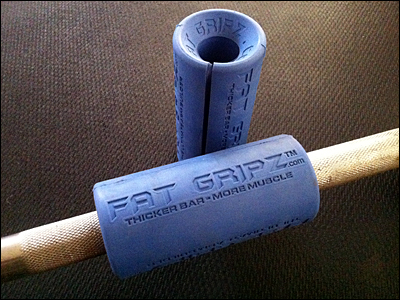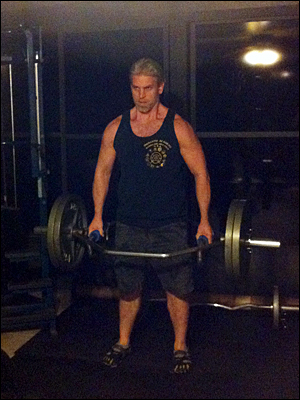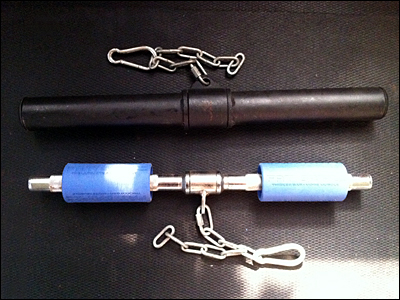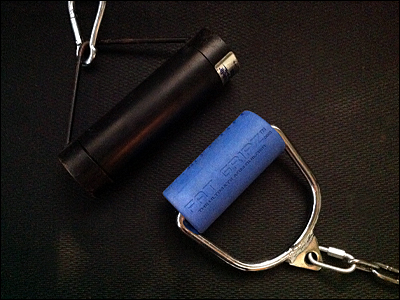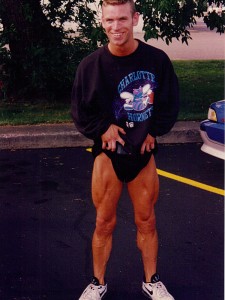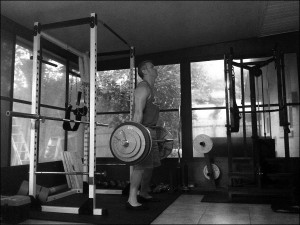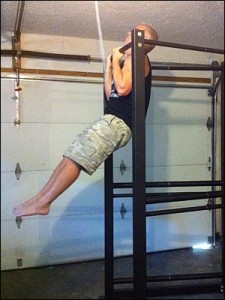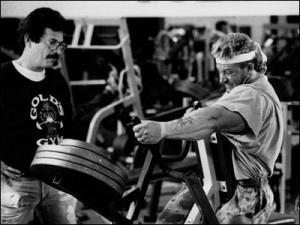There are no secrets to building bigger, more muscular arms. They are like any other part of your body; if you want your arms to get bigger and stronger you have to work them hard and progressively, you have to get enough rest between workouts for recovery and adaptation, and you have to eat properly to support muscle growth. While the basic compound pushing and pulling movements like chest presses, dips, overhead presses, chin ups or pull downs, and rows will improve arm and forearm strength and size considerably, for optimum results more direct work may be required.
You don’t need to do anything fancy, however. You don’t need to perform dozens of different types of curls or triceps extensions using different angles, grip widths, portions of the range of motion, etc. to target different heads of your biceps or triceps. You don’t need to train your arms in different “zones” or “positions of flexion” to work your biceps “peak” or your “lower triceps” or your “delt-bicep tie-in” or similar nonsense. You don’t need to perform every possible movement your hands and wrists are capable of to build a stronger grip or bigger forearms. There are no secret arm or forearm exercises or routines that will make your arms any bigger or stronger than basic, properly performed arm curls, triceps extensions, and wrist curls and extensions.
Biceps
When properly performed a basic barbell, dumbbell, or machine curl effectively works all of the elbow flexors. A supinated grip (palms up) should be used most of the time for grip security and wrist stability. If you want to emphasize your brachioradialis alternate regular arm curls with or occasionally substitute a neutral grip (palms facing each other), also known as “hammer” curls.
It is unnecessary to use different grip widths and shoulder flexion angles (preacher curls, incline bench curls, drag curls, etc.) in an attempt to selectively emphasize the long or short heads of your biceps. Humeral rotation has little effect on the relative involvement of the two heads and extreme shoulder flexion (elbows above the shoulder) should be avoided during arm curls due to active insufficiency of the biceps.
When using a barbell or machine the elbows and grip should be relatively narrow (inside of shoulder width, elbows braced against the lower ribs) to better align the axes of the elbows and the plane of movement of the forearms with consideration for elbow valgus. When using free weights the body position should be such that the forearms are neither vertical at the start or the end of the movement to keep the targeted muscles meaningfully loaded. This means doing the exact opposite of what most people do when curling. Instead of leaning forward at the start so your forearms are vertical, lean back slightly. With your elbows tucked into the front of your lower ribs this will keep the weight more in front of your elbows than below them and the moment arm you are working against will be greater. Instead of leaning back at the end and moving your elbows forward under the weight so your forearms are vertical, slump your chest and lean forward slightly to keep the weight more in front of your elbows than above them.
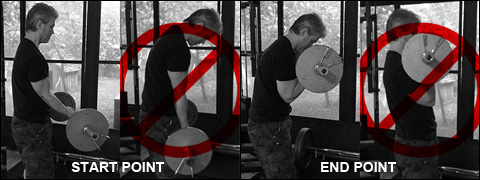
The same principles apply when doing cable curls. Position yourself so the cable comes off the pulley just below where your hands are when starting as described above. If you are closer or further back the moment arms change, reducing the resistance at either the start or the end of the movement.
When using a machine make sure you are properly positioned and your elbows are properly aligned (specifics vary between machines). Keep your shoulders down throughout the movement. Don’t allow your shoulders to rise as you perform the negative so you can “ratchet” the movement arm up at the start of the positive.
Triceps
When properly performed a basic barbell, dumbbell, or machine triceps extension effectively works all three heads of your triceps. There is no need or point in varying your grip. All three heads of your triceps insert onto the olecranon process of your unla, which is not affected by grip position. The best grip is the one that provides the most secure hold and the best wrist stabilization; pronated when using a barbell, neutral for dumbbells (and most triceps machine designs with handles), and if doing cable press-downs use the rope or split-handle attachment with a neutral grip.
Your shoulders should be neutral or flexed (elbows in front of your body) to avoid active insufficiency of the long head of your triceps. Unlike the medial and lateral heads of your triceps which originate on your humerus and only extend your elbow the long head of your triceps originates on the scapula and is also involved in shoulder extension. If your shoulders are extended so your elbows are behind the body the long head of the triceps will already be partially shortened and contribute less to extension of the elbow. Because of this, dumbbell kickbacks and machines like the Nautilus Compound Position Triceps and MedX Triceps are poor triceps exercises.
The best free weight triceps exercises are basic, supine barbell or dumbbell extensions with your elbows held roughly over your nose, which puts your upper arms at around a forty five degree angle. This will keep consistent tension on your triceps over the full range of motion, with the greatest resistance occurring in the stronger mid range position. If your elbows are above your shoulders and your upper arms are vertical the tension will be highest around the start which can be hard on the elbows, and drop off to nothing towards the end when your forearms are vertical and the weight is directly above your elbows. Also, if your elbows over your nose the weight won’t be, which is one less thing to worry about as you approach momentary muscular failure.
It is unnecessary to force your elbows in to point forward or keep your upper arms parallel when doing these. Provided the elbows have some freedom to move as you extend a slight outward angle will be more comfortable and easier on your wrists (using a barbell), elbows, and shoulders. I prefer using an EZ-Curl bar for triceps extensions for wrist comfort.
When using a cable stand far enough back and position your upper body so the line of pull is roughly perpendicular to your forearms in the middle of your range of motion. Do not lean forward or extend your shoulders to reduce the moment arm as you approach the end point.
When using a machine make sure you are properly positioned and your elbows are properly aligned (specifics vary between machines). Triceps machines which position your arms in front of your body are better than machines which position them down by your sides or behind your body.
Forearms and Grip
Although the muscles of the forearms are capable of a variety of hand and wrist movements the majority of them can be worked with just wrist curls and extensions.
When performing wrist curls and extensions your forearms should be angled slightly upwards with your wrists a little higher than your elbows for a better resistance curve. This can be done resting your forearms on your thighs and either sitting on a very low bench or step or sitting on a bench and elevating your feet on a step so your knees are a little higher than your hips. If using a cable attachment and low pulley the further back you are from the pulley the higher the knees should be, so that the line of pull of the cable is perpendicular to your hands when your wrists are bent slightly below neutral.
When using a barbell or straight bar cable attachment to accommodate the bending angle of your wrists your forearms should be angled out slightly (wrists wider than elbows) for curls and in slightly (wrists narrower than elbows) for extensions.
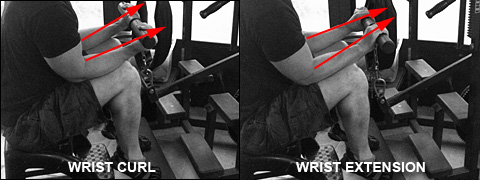
I recommend using a thick bar or thick handled cable attachment (approx two to two and a half inches diameter) for both wrist curls and extensions because it reduces the degree of finger flexion required to grip the bar. This prevents active insufficiency of the wrist and finger flexors during curls and passive insufficiency during extensions. While a thicker bar or handle is more challenging to grip when pulling it is not much harder to hold when performing wrist curls and extensions with the forearms angled up slightly since the fingers or thumbs are working directly against gravity or the pull of the cable over most of the range of motion.
If you want to focus more on your grip strength you can occasionally substitute or alternate these with gripping or timed static contractions or static holds using a thick bar or thick handled cable attachment.
Arm Training Myths and Misconceptions
There is no such thing as a “shaping” exercise for the biceps, triceps, or any other muscle. The general shape of your muscles is genetically determined and the only thing you can do through training is make them larger. You can not preferentially train any longitudinal portion of a muscle, like the “peak” or “mid biceps” or train to produce a “split” biceps shape like Boyer Coe, or train to make your biceps or triceps or any other muscle longer.
There is no such thing as a “cutting” exercise or training technique. While doing any exercise contributes to improvements in body composition in multiple ways (increased lean body mass, acute and chronic increases in metabolic rate, improved glucose metabolism and insulin sensitivity, etc.) getting “cut” is mostly a matter of diet.
There is no special exercise or combination of exercises to develop your “deltoid-biceps tie-in”, the shape of which is genetically determined and the development of which requires nothing more than hard, progressive work on basic exercises and the reduction of bodyfat through proper diet.
It is not necessary to forcefully supinate the hands during curls to fully recruit the biceps. Assuming you are using an adequately heavy weight and proper form every motor unit in your biceps will be recruited within a few reps
General Guidelines for Performance
Initiate each repetition in a deliberate, controlled manner, without jerking, yanking, bouncing, or heaving the weight. If necessary, pause and hold motionless for a second or two without unloading to ensure you do not bounce or elicit a stretch reflex to help with the start.
Lift and lower the weight slowly and focus on intensely contracting the target muscles over the full range of the exercise. Take at least four seconds to complete both the positive and negative phases of the repetition.
When you reach the end point hold the weight motionless for a few seconds before starting the negative. Starting with the third repetition gradually squeeze the target muscles during this hold.
Gradually “un-squeeze” the target muscles as you begin the negative. Don’t drop the weight.
Maintain strict body position throughout the exercise. Do not lean, shift or alter your body position in any way that takes tension off of the target muscles.
Do not turn your head to admire your biceps as you curl. Maintain a neutral head and neck position during all exercises.
When performing wrist extension with dumbbells position your hands towards the outside of the handles so your thumbs are closer to the center.
Further Reading
For more detailed guidelines and arm specialization routines read High Intensity Workouts, available in the HIT store.
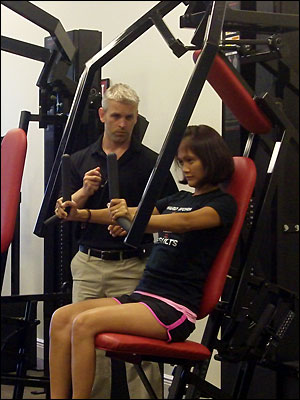 If you’re thinking of becoming a personal trainer the most important thing to ask is whether it is something you really want to do, something you are passionate about. If not, find what that thing is and do it instead. You only live once and you shouldn’t waste years of your life in a job you don’t enjoy.
If you’re thinking of becoming a personal trainer the most important thing to ask is whether it is something you really want to do, something you are passionate about. If not, find what that thing is and do it instead. You only live once and you shouldn’t waste years of your life in a job you don’t enjoy.

